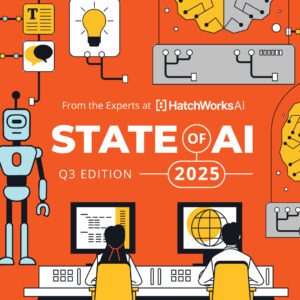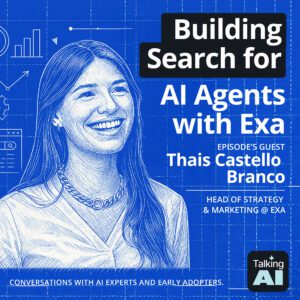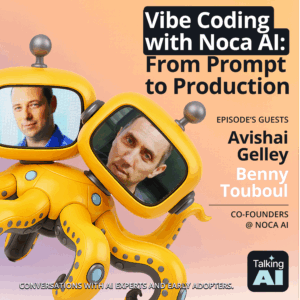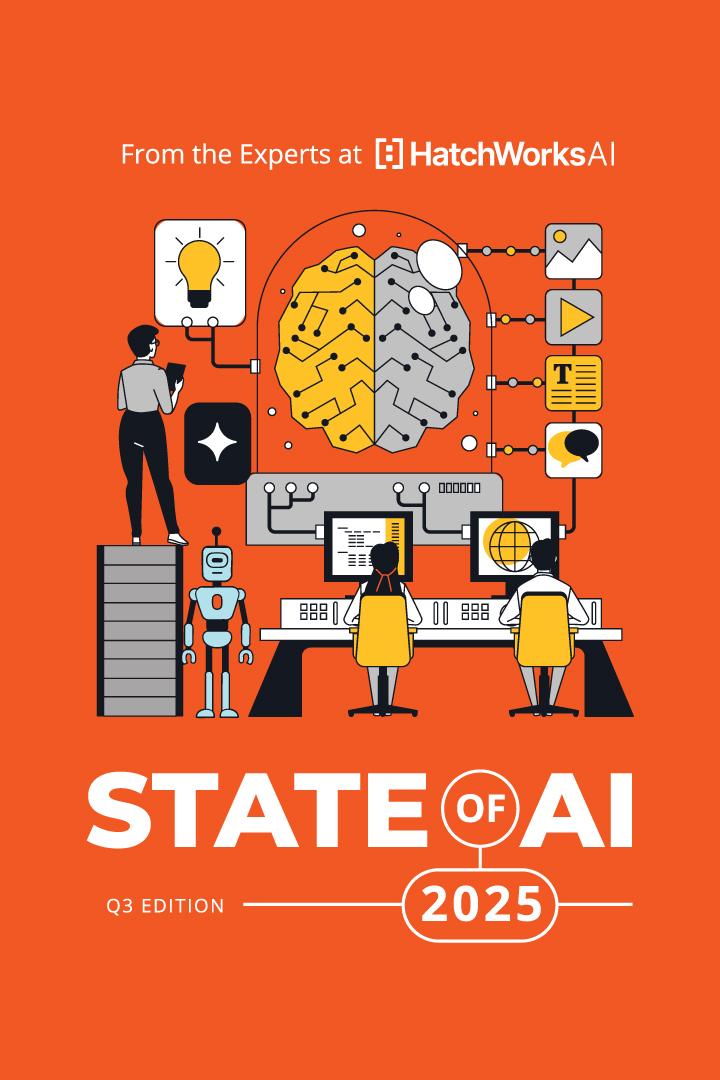I don’t know about you, but I didn’t expect artificial intelligence to evolve as fast as it has. Yet here we are—talking about AI agents that don’t just follow instructions but operate with real autonomy.
So, what exactly are autonomous agents? And how are they reshaping the way businesses use AI?

In this article, we’re breaking it all down—what they are, how they work, and how you can implement them to get real value from their capabilities.
Because jumping on an AI trend only for it to fail isn’t the goal. We’re here to help you get it right from the start.
What are Autonomous Agents?
Think of autonomous agents as AI’s answer to independent problem-solvers. These agents operate with a kind of digital self-sufficiency, pulling in data, weighing options, and executing actions. And they do so without human intervention.
Traditional deterministic systems are often stuck in a loop of if-this-then-that, but autonomous agents are built to navigate dynamic, unpredictable environments. They can:
- Sense what’s happening by pulling in real-time data from APIs, sensors, or databases.
- Think on their feet by using models like reinforcement learning, large language models (LLMs), or a combination of strategies to choose the best action.
- Act with purpose by sending instructions to systems, APIs, or physical devices to complete a task.
- Learn from the outcome—whether they succeed or fail—refining their strategies to do better next time.
Want more resources on AI agents? Check out our article AI Agents Explained.
How Autonomous Agents Work
At a technical level, autonomous agents operate using a loop of perception, reasoning, execution, and feedback. This requires machine learning, natural language processing (NLP), and real-time data analysis.

Let’s look at a few key stages of the process and how they work.
1. Perception & State Management
Autonomous agents start by gathering data from APIs, databases, sensors, or user inputs. Unlike simple function calls, they maintain a stateful understanding of their environment, often using:
- Vector databases (e.g., FAISS, ChromaDB) – Storing and retrieving embeddings for long-term memory.
- Context windows & short-term memory – Using LLMs like GPT-4-turbo or Claude for immediate decision-making.
- Multi-modal inputs – Incorporating text, images, and structured data for richer reasoning.
2. Decision-Making & Planning
Unlike basic automation, autonomous agents plan ahead instead of just executing a single command. This is where AI models and decision frameworks come in:
- LLM-based reasoning – Using models like GPT-4 or Mixtral for high-level decision-making.
- Reinforcement Learning (RL) – Agents trained with reward models refine their approach over time (e.g., OpenAI Gym, Deep Q Networks).
- Symbolic AI & hybrid approaches – Combining rule-based logic with probabilistic reasoning for structured decision-making.
- Hierarchical agents – Breaking down complex tasks into sub-agents that specialize in planning, execution, and error recovery.
3. Action Execution & Tool Use
Once an agent makes a decision, it needs to execute it by interfacing with external systems. This happens via:
- Function calling & API orchestration – Agents call APIs (e.g., OpenAI’s function calling, LangChain tools) to fetch data, trigger workflows, or modify states.
- Autonomous scripting – Generating and running Python, Bash, or SQL scripts dynamically.
- Agent frameworks – Using tools like LangChain, CrewAI, AutoGPT, or BabyAGI to handle multi-step execution with retries and optimizations.
- Self-healing mechanisms – Detecting failures and adjusting execution plans dynamically.
- MCP – MCP defines a structured way for AI agents to maintain, update, and share their working context throughout action execution. It ensures that as agents interact with external systems—through function calling, autonomous scripting, or agent frameworks—they consistently track their goals, environment, decisions, and outcomes. This dynamic context management enables agents to make better decisions, recover from failures (self-healing), and optimize multi-step workflows effectively.
4. Feedback Loops & Learning Mechanisms
A key difference between static automation and autonomous agents is their ability to iterate and improve. This is done through:
- Retrieval-Augmented Generation (RAG) – Enhancing responses with real-time external knowledge. (We have loads of resources on RAG, if you need more insight.)
- Reinforcement learning with human feedback (RLHF) – Fine-tuning agent behavior based on past successes and failures.
- Memory persistence – Storing useful interactions for future reference, improving long-term autonomy.
An Example: How an Autonomous Agent Books a Trip
Say you ask an AI travel assistant to plan a ski trip. Instead of guessing, the agent follows a structured loop:
- Observe: It starts by pulling in real-time info using tools—like calling flight or hotel APIs. It doesn’t scrape data—it receives structured responses. This is how the agent “sees” the world.
- Think: Based on what it observes, it reasons about next steps. Should it look up weather conditions? Filter options by budget?
- Act: It takes action—maybe querying a weather API or checking hotel availability.
- Observe again: New data comes in, and the agent adjusts. If a flight is full, it tries a different option. If a hotel’s booked, it finds alternatives.
This loop—Observe → Think → Act → Observe—continues until the trip is booked. The key? The agent doesn’t follow a script. It reasons in real time, adapting with every outcome.
Watch Autonomous AI Agents in Action
Ready to see AI agents in action? Check out our recent webinar, Make AI Agents Your Workforce Multiplier, where our experts dive deeper into how autonomous agents can become powerful extensions of your workforce.
You’ll learn exactly what AI agents do, see a live demonstration using Databricks’ Mosaic AI Gateway, and explore practical use cases you can deploy today.
Types of Autonomous Agents
Not all autonomous agents operate the same way. Some react instantly, others plan ahead, and a few even attempt to understand human intent.
There are distinct categories based on their level of intelligence and adaptability. Here are a few:
ReAct Agents (Reason + Act AI)
ReAct agents represent a more capable class of AI agents that combine reasoning with decision-making in real time. The term “ReAct” refers to a prompt engineering framework designed for language models like GPT-4. Rather than simply responding to inputs, these agents alternate between generating thoughts and taking actions, allowing them to work through problems step by step.
This approach enables agents to:
- Break down complex tasks into logical steps
- Reflect on progress before taking the next action
- Handle dynamic or uncertain environments with greater flexibility
The ReAct loop typically looks like this:
Thought → What should I do?
Action → Try a solution or query a tool
Observation → What happened as a result?
Then it loops: the next thought is informed by the previous observation.
Even though ReAct agents don’t have persistent long-term memory, they can reason through problems in the moment, keeping track of context within a session and adjusting as they go. This makes them far more capable than purely reactive or rule-based agents.
Examples:
A ReAct-powered customer service agent might reason through a troubleshooting workflow by querying a knowledge base, testing one solution, then reevaluating based on feedback.
An AI research assistant could chain together tool calls such as retrieving a document, summarizing it, then citing sources.
Used in: Conversational agents, research assistants, retrieval-augmented generation (RAG) systems, AI planners and tool users.
Limited Memory Agents (Short-Term Adaptation)
These agents have short-term memory that allows them to make better decisions based on recent data but lack long-term learning capabilities. Most modern AI systems fall into this category.
Example:
- Self-driving cars use LiDAR and sensor data to adjust their driving path but don’t remember past trips.
- AI assistants like Siri & Alexa recall previous sentences within a session but reset afterward.
Used in: Autonomous vehicles, predictive analytics, dynamic pricing algorithms.
Theory of Mind Agents (Context-Aware, Human-Centric AI)
These agents attempt to model human emotions, beliefs, and intentions to improve interactions. While we’re not quite there yet, large language models (LLMs) like GPT-4 show early steps toward this.
Example:
- Advanced conversational AI that detects frustration and adjusts tone (e.g., AI-powered customer support).
- Negotiation bots that predict a human’s bargaining strategy and adjust their offers.
Used in: Social AI, adaptive learning platforms, high-level business decision-making.
Fully Autonomous & Self-Aware Agents (Goal-Driven AI)
This is the ultimate level—AI agents that can set their own objectives, self-improve, and operate independently for long periods.
While true self-awareness in AI is still theoretical, some AI systems today exhibit traits of autonomous decision-making and self-optimization.
Example:
- AlphaGo Zero—learned to play Go from scratch without human input.
- Autonomous research agents that generate, test, and refine hypotheses (used in drug discovery).
- Multi-agent financial trading systems that adjust investment strategies dynamically.
Used in: AI-driven R&D, autonomous robotics, advanced reinforcement learning applications.
Applications of Autonomous Agents
From financial trading bots to AI-driven logistics, these autonomous agents are already at work across key sectors. Let’s look at what exactly they’re working on.
Smarter Healthcare: From Diagnosis to Drug Discovery
In medicine, AI-driven agents are scanning X-rays for early signs of disease, adjusting treatment plans in real time, and even assisting in drug discovery.
Hospitals use them to optimize patient scheduling, and researchers deploy them to analyze vast datasets for genetic insights. Imagine an AI that constantly refines its diagnosis model, learning from every new patient case without needing explicit reprogramming. That’s where we’re headed.
Example: IBM’s Watson for Oncology was developed to provide evidence-based treatment recommendations for cancer patients. It analyzes medical literature and patient data to suggest personalized treatment options.
Finance: Trading at the Speed of Light
High-frequency trading firms rely on autonomous agents to make split-second decisions that human traders simply can’t.
These AI-driven systems scan market conditions, execute trades, and refine their strategies in milliseconds. Risk assessment agents work in parallel, flagging fraudulent transactions before they cause damage.
The financial world has always thrived on speed—AI just took that to another level.
Example: JPMorgan’s LOXM is an AI program designed to execute equity trades in real-time, optimizing speed and price by learning from billions of past trades. In trials, LOXM outperformed existing manual and automated trading methods.
Retail & E-Commerce: AI Knows What You Want Before You Do
Ever wondered why product prices on Amazon shift constantly? That’s autonomous pricing agents at work, adjusting costs based on demand, competitor activity, and even your browsing history.
AI-driven supply chain agents predict inventory needs before shortages happen, while fulfillment centers use fleets of self-organizing robots to pack and ship orders more efficiently than any human team ever could.
Example: Dynamic Pricing Algorithms are used by e-commerce platforms to adjust product prices in real-time based on demand, inventory levels, and competitor pricing, thereby maximizing profits and market competitiveness.
Transportation & Logistics: The Road Ahead is Autonomous
Self-driving trucks are already hauling freight, and last-mile delivery drones are testing urban skies. But beyond vehicles, AI logistics agents are rewriting how goods move.
These systems anticipate traffic delays, reroute shipments in real time, and even factor in weather patterns. The goal? A supply chain that thinks for itself and where disruptions are solved before they cause problems.
Example: Lyft has partnered with Intel’s Mobileye and Japanese conglomerate Marubeni to introduce a fleet of robotaxis. The service is slated to launch in Dallas by 2026, with plans to expand to additional markets.
Benefits of Autonomous Agents
Work That Never Stops (and Never Slows Down)
Picture a warehouse where thousands of packages need sorting every hour. In the past, human workers had to do the heavy lifting, bending, reaching, and moving items for hours on end.
Now? AI-powered robots like Amazon’s Robin and Cardinal handle those jobs, lifting and sorting with machine precision. Humans step in to solve complex problems, ensuring quality, and keeping operations running smoothly.
And it’s not just warehouses. In financial markets, autonomous trading agents execute trades in milliseconds, spotting opportunities that no human could react to in time.
Safer Jobs, Smarter Decisions
When a Volvo self-driving truck pulls onto the highway, it doesn’t get distracted, it doesn’t text, and it doesn’t get tired. It calculates braking distances, anticipates sudden stops, and adjusts for changing road conditions.
With sensors scanning the environment 360 degrees at all times, autonomous freight vehicles are designed to make roads safer, cutting down on the human errors that cause most accidents.
What to Look for When Implementing Autonomous AI Agents
If you want AI agents that actually deliver results (instead of becoming an overhyped expense), follow these concrete steps:
Step 1: Define the Use Case—What Problem Are You Solving?
Before considering AI, pinpoint the exact process or decision that needs automation. Ask:
- What tasks are repetitive, time-consuming, or prone to human error?
- Where does decision-making need to be faster and more data-driven?
- What areas need 24/7 automation or real-time response capabilities?
How to Do It:
- Map your existing process: List out each step currently performed by humans. Identify inefficiencies, bottlenecks, or error-prone areas.
- Determine the role of AI: Will the agent assist, fully automate, or act as a decision-support system?
- Talk to stakeholders: Employees and managers involved in the process will have valuable insights into what could (and should) be automated.
- Quantify the potential benefits: Estimate the time, cost, or risk reduction AI could bring.
Step 2: Choose the Right Type of Autonomous Agent
There’s no one-size-fits-all AI agent. Depending on the task, you’ll need different approaches:
| Type of Agent | Best For | Example Use Case |
|---|---|---|
|
Rule-Based Agents
|
Simple, predefined workflows
|
A chatbot for basic customer FAQs
|
|
Learning Agents (ML/RL)
|
Tasks requiring adaptation over time
|
AI fraud detection that evolves based on patterns
|
|
Planning Agents
|
Multi-step decision-making
|
AI-powered job scheduling and workforce management
|
|
Multi-Agent Systems
|
AI agents working together
|
Supply chain optimization, where one agent forecasts demand and another manages inventory
|
How to Do It:
- Identify whether the task is static or dynamic. If conditions rarely change, a rule-based agent might be enough. If real-time learning is required, consider reinforcement learning (RL).
- Consider whether multiple AI agents need to interact. If different parts of the process require coordination, multi-agent systems might be necessary.
- Determine the level of human oversight needed. Some systems should act independently, while others should require human approval for critical decisions.
You also need to decide if you’re going to use a pre-built agent or create autonomous agents from scratch.
For businesses that want quick deployment without heavy development work, prebuilt AI agents are the fastest way to get started.
When this makes sense:
- You need AI automation but don’t have in-house AI expertise.
- Your use case is common (e.g., customer support, marketing automation, logistics optimization).
- You want a solution that integrates easily with existing platforms (CRMs, databases, APIs).
Step 3: Assess Data Readiness—Can AI Learn From Your Existing Systems?
AI agents only work if they have clean, structured, and relevant data. Garbage in, garbage out.
How to Do It:
- Audit existing data sources. Where will the AI agent pull information from? Are databases structured properly?
- Ensure real-time or batch processing compatibility. Does the AI agent need live streaming data, or can it work with periodic updates?
- Check for missing or biased data. AI agents trained on incomplete or skewed data will produce unreliable results.
Step 4: Prioritize Integration—AI Must Fit Into Your Tech Stack
A common reason AI agents fail? They don’t integrate smoothly with existing workflows. You don’t want a standalone system that requires constant manual intervention. So let’s look at how you can integrate autonomous agents flawlessly into your systems.
How to Do It:
- List out the platforms the AI needs to interact with. CRM, ERP, databases, APIs? Does it need to read/write data, trigger workflows, or provide real-time recommendations
- Check for API compatibility. Some AI agents come with pre-built integrations, while others require custom development.
- Ensure the AI can explain its decisions. Black-box AI can be a nightmare for compliance-heavy industries like finance and healthcare.
Step 5: Start Small—Pilot Before Full Deployment
AI adoption fails when companies rush into large-scale implementation before proving its value. Instead, test in a controlled environment first.
How to Do It:
- Select a single use case in one department. Don’t automate everything at once—choose a contained workflow to start.
- Monitor key performance indicators (KPIs). Track efficiency gains, error rates, cost savings, or accuracy improvements.
- Collect user feedback. The AI agent should improve over time based on user input.
- Refine and optimize. Adjust based on what works and what doesn’t before scaling.
Step 6: Measure ROI—Prove the Business Impact
AI isn’t a magic bullet, and you need to justify its investment. After deployment, continuously evaluate whether it’s delivering the expected value.
How to Do It:
- Calculate time saved per employee. Is the AI reducing workload, or is it creating new inefficiencies?
- Analyze cost reduction. Has automation cut expenses, or are there hidden costs (e.g., maintenance, model retraining)?
- Measure performance improvements. Is the AI making better decisions than humans, or is it just faster?
- Assess adaptability. Can the AI handle real-world edge cases, or does it break down in unexpected scenarios?
Want to explore how autonomous AI agents can transform your business?
The best AI solutions aren’t the ones with the most hype. They’re the ones that integrate seamlessly, enhance productivity, and actually deliver ROI.
But it can be difficult to tell the difference.
At HatchWorks AI, our solutions help businesses use AI strategically. Whether building something from scratch or deploying pre-built models, we’re here to guide you every step of the way—or in some cases, take it off your hands completely.
Here’s a quick look at the services we offer:
- AI Strategy & Roadmap – We train your team, identify high-ROI use cases, and build solutions that turn your AI ambition into reality.
- AI-Powered Software Development – From crafting AI-native experiences to accelerating development with agentic workflows, we use AI to transform how software is built and modernized.
- Data Engineering & Analytics – We help you turn your data into a strategic asset for AI
- AI Engineering Teams – We can accelerate your AI initiatives with elite expertise across the US and Latin America plugged right into your teams
Want to learn more about how we can help you adopt AI in the right way? Get in touch here.
Identify Your Top AI Agent Use Cases
The AI Agent Opportunity Lab helps you discover and prioritize high-impact AI agent opportunities tailored specifically to your business objectives.




